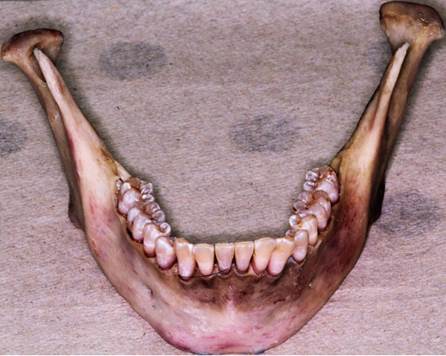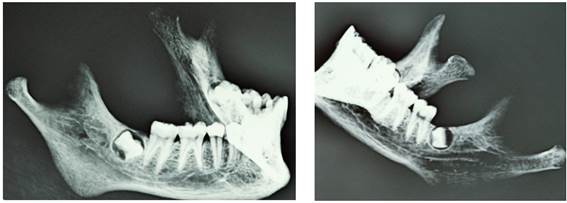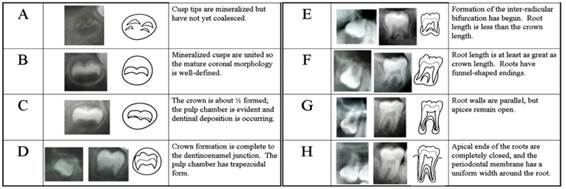Introduction
One of the biggest challenges in forensic dentistry is age estimation, which may be required in living individuals, cadavers, and skeletal remains (1). The age range may include or exclude some methods, for example, the two most used dental methods in Costa Rica in both cadavers and skeletal remains are Lamendin´s method (root translucency) (2), and the estimation based on the crown-root formation according to Demirjian stages, where the third molars are transcendental in people close to the age of majority (18 years old) (3).
The technique of root translucency or Lamendin's method was developed in 1978 by Dr. Henri Lamendin who analyzed the total length of the root with the root translucency, later in 1992, he modified Gustafson's method and generated a new equation that took into account the periodontosis (distance between the enamel-cement junction to the bone crest), the root transparency and the total length of the root , this technique has been used in multiple populations and has proven to be extremely useful and with little margin of error, however, it is only useful in individuals over 20 years of age (4-8)
Dental development as a parameter for age estimation has been widely studied for many years. In 1963 Moorrees and Fanning described how teeth constitute one of the main pillars in age estimation (9), In 1973 Demirjian developed another system for age estimation based on dental development that has been applied to this day (3).
The sequence of tooth eruption is also extremely useful, however, in subjects near the age of majority (18 years of age) the best indicators in terms of age are the third molars. The development of the third molars has been extensively studied for age establishment and has even been validated by the American Board of Forensic Odontology A.B.F.O. (10-13).
Materials and Methods
For this study, a literature search was performed using different virtual platforms such as PubMed, Scielo and Medline with the keywords: Lamendin, Demirjian, third molars, mineralization, age estimation.
Case Report
The case is presented of three male individuals who were dismembered and placed inside plastic bags that were abandoned in a wooded area; one was suspected to be a minor, and the request directed to forensic odontology was to determine which of them was under 18 years of age.
In this specific case, Lamendin's method was not useful because it can only be used in adults after the age of 20(2), so it was decided to use the development of the lower third molars based on Demirjian's stages, using the modification of Solari and Abramovitch (12), for having conducted the study in a Hispanic population.
First, a clinical examination of the three corpses that were in a state of putrefaction was performed; all presented similar clinical characteristics in terms of height and complexion. Upon intraoral examination, it was observed that one showed dental characteristics compatible with a young person (Figure 1), and in the area corresponding to the lower third molars there were areas of osteolysis compatible with a dental eruption process (Figures 2 and 3).

Figure 1 Frontal photograph of the mandible, presence of good periodontal and dental condition. In the right retromolar area the third lower molar is in the process of eruption.

Figures 2 and 3. Right and left retromolar areas respectively, on the right there is initial osteolysis in the gingival emergence process and the coronal portion is observed (fig.2), on the left there is only initial osteolysis (fig. 3).
Subsequently, right, and left oblique radiographs of the mandible were taken to determine the degree of development according to Demirjian's stages, and thus rule out that the molars were developed and impacted (figures 4 and 5). The radiographically observed stage of both lower third molars corresponded to D, where the complete crown is formed up to the amelodentinal junction and the pulp chamber has a trapezoidal beginning (figure 6).

Figures 4 and 5. Oblique radiographs of the right and left mandible showing the lower third molars, both in stage D.
Demirjian stage D according to the tables developed by Solari and Abramovitch (12), has an average age in lower third molars of 15.5 years with a standard deviation of 1.5 years (Figure 7).

Figure 6 Graphical and radiological representation of third molar development. Taken from Kasper et al (13).

Figure 7 Mean age and standard deviation calculated in Hispanic population by Solari and Abramovitch (12).
Discussion
Age estimation by dental methods is attributed to the Romans who used it in military recruitment, however it was scientifically applied until the 1800s to determine the age of children for labor purposes. (14).
Teeth have been shown to be one of the anatomical structures of the human body that suffer less alteration by environmental factors and consequently have less error in age estimation(15-21)
The third molars are dental structures that are characterized by erupting around the age of 18 and for this reason, they are called "wisdom teeth" where it is assumed that a person reaches the age of majority and therefore has the capacity of judgment.
Third molar formation has been extensively studied and estimation based on Demirjian stages is widely used in the literature, has been analyzed in multiple populations, and has been shown to have a high degree of accuracy (12,13,22).
Age determination by Demirjian stages in third molars has already been tested in the Latin American population, and there are multiple studies in Latin America that demonstrate its effectiveness. Studies have shown that there is little variation between populations, but it is recommended that each population conduct its own studies to determine whether the stages are applicable or should be adjusted according to statistical results (23-26).
Conclusions
The method of age estimation by mineralization of the third molars is extremely useful when it is necessary to establish the age of majority (18 years). It is highly accurate, fast, and economical since only radiological studies are needed for its performance, and it presents little alteration due to environmental factors during development.















